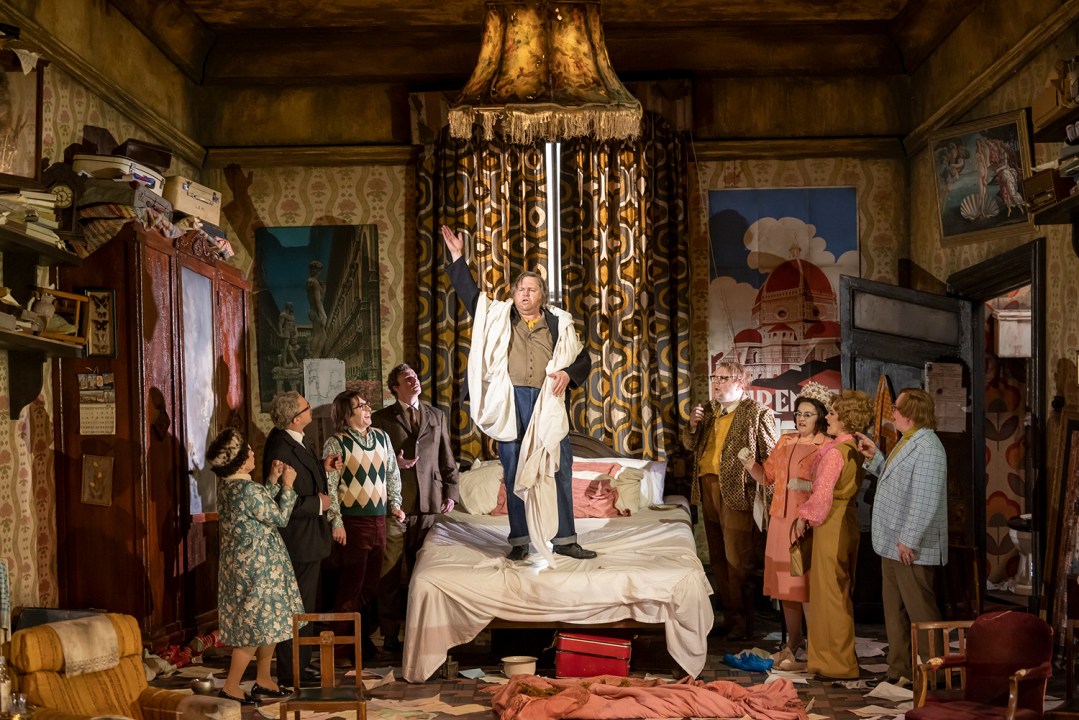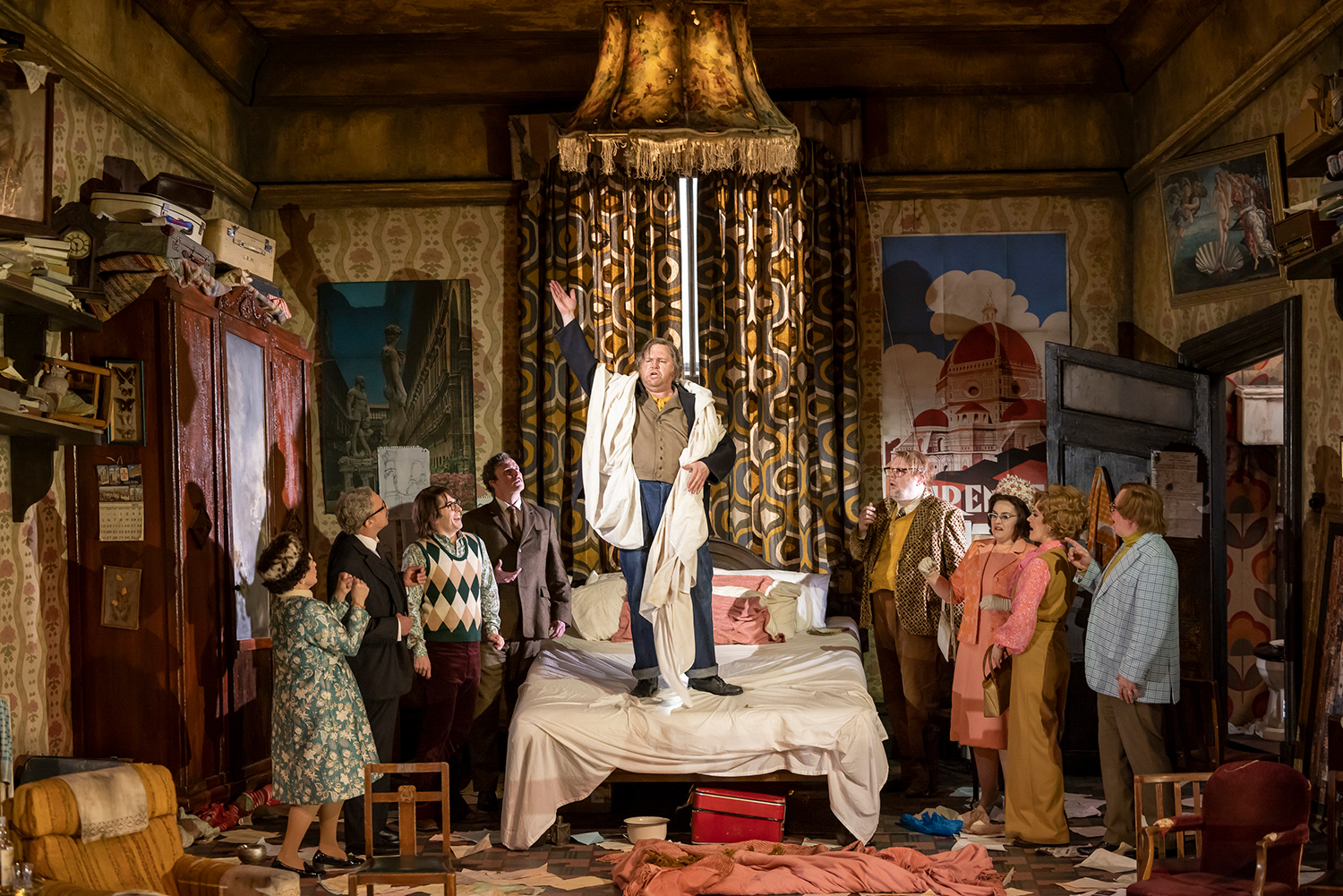It does no harm, once in a while, to assume that the creators of an opera actually know what they’re doing. Puccini was clear that he wanted the three one-act operas of Il trittico to be performed together and in a particular order. Promoters and directors have had other ideas, and between the wars it was apparently common to perform the triptych’s comic final opera, Gianni Schicchi, in a double bill with Strauss’s Salome, which must have been an interesting night out. Come for the necrophilia, stay for the lulz.
But Scottish Opera’s new production presents Il trittico in the form the composer intended, and what d’you know? It works. Four hours (including intervals) is hardly excessive – we’ve all binge-watched longer box sets – and in return you get the full Puccini once-over: from the noirish slow burn of Il tabarro, through the emotional wringer of Suor Angelica and out into the comic sunburst of Gianni Schicchi. Puccini eases into his solid-gold showstopper ‘Il mio babbino caro’ at exactly the point that a Broadway composer would deploy their ‘11 o’clock number’: the tune, in other words, that you get to take home.
This is as faithful a Trittico as Puccini could have hoped for
In Scotland, it arrives shortly before 10 p.m., but in every other respect David McVicar’s staging is as handsome, as entertaining and – when performed as well as this – as faithful a Trittico as Puccini could have hoped. I say faithful: all three operas have been updated to a generic postwar period (we’re given the date 1971 in Gianni Schicchi but Il tabarro and Suor Angelica could be anything up to three decades before that) and settings that could be Paris or Florence but might equally – judging from the shipyard cranes and baronial towers of designer Charles Edwards’s backdrops – be Glasgow itself.
The main point is that it’s naturalistic, and full of visual delights: whether the barge slipping through oily waters in the opening tableau of Il tabarro or the mildewed chaos of Buoso Donati’s decrepit merchant palace in Schicchi. McVicar populates the stage with sharply drawn characters and details (keep an eye on Buoso’s stash of girlie mags, kept under the bed next to his chamber pot). It’s a vivid physical counterpoint to the taut but transparent sounds that Stuart Stratford draws from the orchestra: muted trumpets as switchblades in Il tabarro, and basses chanting like confessors beneath Sister Angelica’s agonies. Such atmosphere, and such subtlety of colour: Stratford’s conducting reminds you why Diaghilev rated Puccini so highly.
But still, the audience gave a quiet sigh of pleasure when Francesca Chiejina, a gloriously sunny Lauretta, sang ‘Il mio babbino caro’. She has a voice like a particularly succulent Rioja, and as Sister Genovieffa in Suor Angelica she’d already melted all resistance – a really nice bit of cross-casting. Richard Suart’s cameo as the physician in Schicchi was another inspired touch, while the presence of Louise Winter as La Frugola and Karen Cargill as the Princess in the two preceding operas gives some idea of the general strength in depth.
Roland Wood was Michele in Il tabarro, confining his pain within stark, charcoal-black vocal lines until the final deadly rupture. Then he turned himself inside out as Schicchi: a donkey-jacketed Teddy Boy with an exuberant line in vocal bluster. And Sunyoung Seo, a yearning, heartsore Giorgietta in Il tabarro, pushed her voice to (but not beyond) snapping point as Angelica, in a performance so raw, and yet so dazzling in its concentration, that… well, it does no-one any favours to invoke Callas, no matter how remotely. But Seo spared herself nothing, and lifted a richly enjoyable night of opera into something that burned itself on to the memory. If you’re anywhere near Edinburgh this weekend, you should do whatever it takes to get a ticket.
At the Wigmore Hall, the 17 players of the Basel Chamber Orchestra squeezed themselves around Kristian Bezuidenhout’s fortepiano for a programme of Mozart and J.C. Bach, plus – an outlier for this period-instrument ensemble – a new suite of short, moody musical sketches by the Slovak-Swiss composer Iris Szeghy. Mozart was the main story here, though. With a fortepiano rather than a harpsichord the familiar percussive attack was absent from the texture, and although Bezuidenhout spoke about Mozart’s own creativity at the keyboard, his own contribution simply vanished, inaudible, beneath some particularly buoyant and gutsy ensemble playing.
Alina Ibragimova was the soloist in Mozart’s Fourth Violin Concerto – dancing around the orchestra, but less than entirely surefooted, intonation-wise, in this low-vibrato environment. The final item was the 18-year-old Mozart’s Symphony No.29 and at last it sounded as if everyone had ditched their inhibitions. There’s something miraculous about these early masterpieces of Mozart’s late adolescence; something irrepressible and Apollonian. The horns whooped the roof off in the final bars, and it felt good to be alive.







Comments